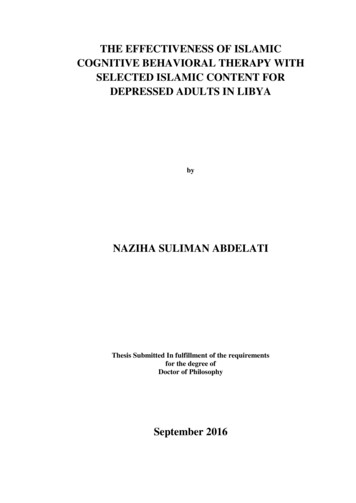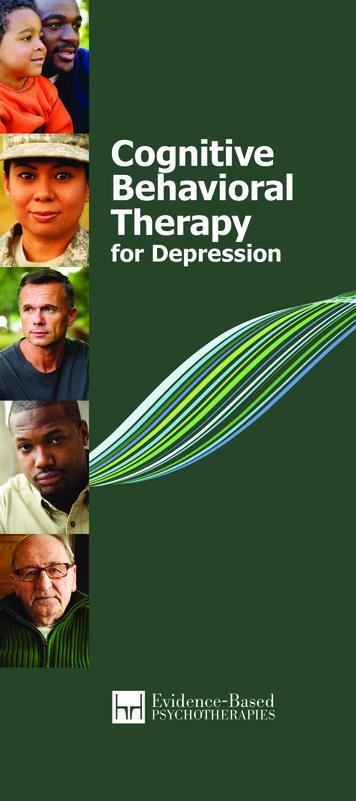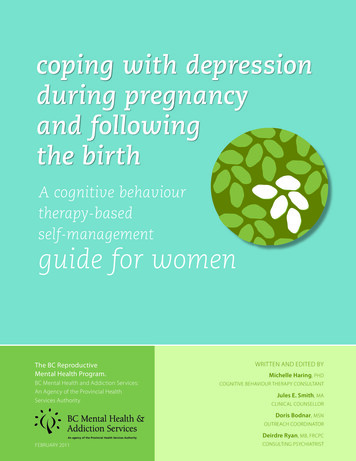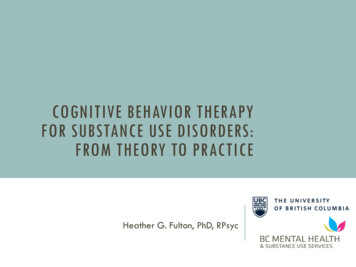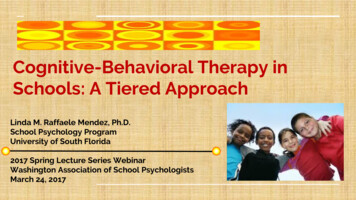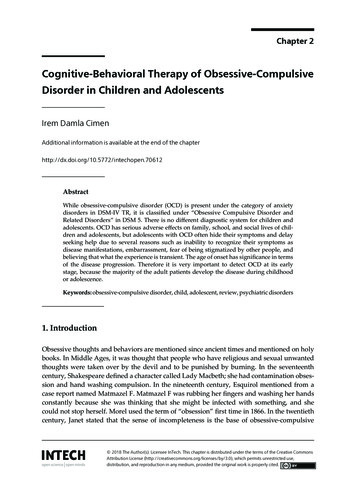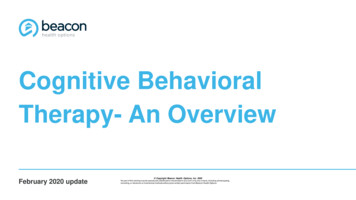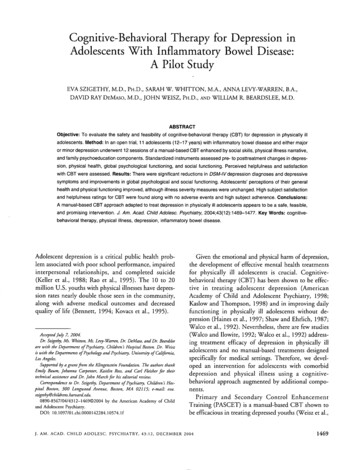
Transcription
Cognitive-Behavioral Therapy for Depression inAdolescents With Inflammatory Bowel Disease:A Pilot StudyEVA SZIGETHY, M.D., PH.D., SARAH W. WHITTON, M.A., ANNA LEVY-WARREN, B.A.,DAVID RAY DEMASO, M.D., JOHN WEISZ, PH.D., AND WILLIAM R. BEARDSLEE, M.D.ABSTRACTObjective: To evaluate the safety and feasibility of cognitive-behavioral therapy (CBT) for depression in physically illadolescents. Method: In an open trial, 11 adolescents (12-17 years) with inflammatory bowel disease and either majoror minor depression underwent 12 sessions of a manual-based CBT enhanced by social skills, physical illness narrative,and family psychoeducation components. Standardized instruments assessed pre- to posttreatment changes in depression, physical health, global psychological functioning, and social functioning. Perceived helpfulness and satisfactionwith CBT were assessed. Results: There were significant reductions in DSM-/Vdepression diagnoses and depressivesymptoms and improvements in global psychological and social functioning. Adolescents' perceptions of their generalhealth and physical functioning improved, although illness severity measures were unchanged. High subject satisfactionand helpfulness ratings for CBT were found along with no adverse events and high subject adherence. Conclusions:A manual-based CBT approach adapted to treat depression in physically ill adolescents appears to be a safe, feasible,and promising intervention. J. Am. Acad. Child Adolesc. Psychiatry, 2004;43(12):1469-1477. Key Words: cognitivebehavioral therapy, physical illness, depression, inflammatory bowel disease.Adolescent depression is a critical public health problem associated with poor school performance, impairedinterpersonal relationships, and completed suicide(Keller et al., 1988; Rao et al., 1995). The 10 to 20million U.S. youths with physical illnesses have depression rates nearly double those seen in the community,along with adverse medical outcomes and decreasedquality of life (Bennett, 1994; Kovacs et al., 1995).Accepted July 7, 2004.Dr. Szigetly, Ms. Whitton, Ms. Levy-Warren, Dr. DeMaso, and Dr. Beardsleeare with the Department of Psychiatry, Children s Hospital Boston. Dr. Weiszis with the Departments ofPsychology and Psychiatry, University of California,Los Angeles.Supported by a grantfrom the Klingenstein Foundation. The authors thankEmily Baum, Johanna Carpenter, Kaitlin Ross, and Carl Fleisher for theirtechnical assistance and Dr. John Marchfor his editorialreview.Correspondence to Dr. Szigethy, Department of Psychiatry, Childrens Hospital Boston, 300 Longwood Avenue, Boston, MA 02115; e-mail: 12-1469 2004 by the American Academy of Childand Adolescent Psychiatry.DOI: 10.1097/01.chi.0000142284.10574.ifGiven the emotional and physical harm of depression,the development of effective mental health treatmentsfor physically ill adolescents is crucial. Cognitivebehavioral therapy (CBT) has been shown to be effective in treating adolescent depression (AmericanAcademy of Child and Adolescent Psychiaty, 1998;Kaslow and Thompson, 1998) and in improving dailyfunctioning in physically ill adolescents without depression (Haines et al., 1997; Shaw and Ehrlich, 1987;Walco et al., 1992). Nevertheless, there are few studies(Walco and Ilowite, 1992; Walco et al., 1992) addressing treatment efficacy of depression in physically illadolescents and no manual-based treatments designedspecifically for medical settings. Therefore, we developed an intervention for adolescents with comorbiddepression and physical illness using a cognitivebehavioral approach augmented by additional components.Primary and Secondary Control EnhancementTraining (PASCET) is a manual-based CBT shown tobe efficacious in treating depressed youths (Weisz et al.,J. AM. ACAD. CHILD ADOLESC. PSYCHIATRY, 43:12, DECEMBER 20041469
SZIGETHY ET AL.1997). PASCET is based on the premise that adolescents show increased vulnerability to depression due toskill deficits (i.e., unengaging social style) and maladaptive habits of thought (i.e., negative cognitive distortions) in response to distressing or ambiguous lifeevents (i.e., a physical illness) (Weisz et al., 1999).PASCET enhances coping skills using a two-processmodel of perceived control. Primary control involvesincreasing the rewarding or reducing the punishing aspects of one's environment by bringing objective conditions into closer conformity with one's wishes.Secondary control involves adjusting one's beliefs aboutobjective conditions, influencing subjective impact ofevents without altering the events themselves (Lazarus,1980; Rothbaum et al., 1982; Weisz et al., 1994). Foradolescents with comorbid depressive and physical illnesses, PASCET is a logical treatment approach giventhat locus of control has been implicated in both illnesses (Band and Weisz, 1988; Peterson, 1989; Weiszet al., 1994; Worchel et al., 1987).Due to issues of medical illness severity and the extrafamily burden entailed, we augmented PASCET withsocial skills training (Engstrom, 1999; Ferry, 1999;Moody et al., 1999), family educational approaches(Beardslee et al., 2003; Fristad et al., 2002), and physical illness narratives (DeMaso et al., 2000; Smyth et al.,1999). These components enhance self-understandingand illness comprehension, important components ofresiliency to depression (Beardslee, 1989; Focht andBeardslee, 1996) and physical illness (Engstrom, 1999).Inflammatory bowel disease (IBD) is a model illnessfor CBT because of its high morbidity and depressionrates (Engstrom, 1999; Hofley and Piccoli, 1994;McKegney et al., 1970). This autoimmune disorder issubdivided into Crohn disease and ulcerative colitis.Each presents with recurrent abdominal pain, bloodydiarrhea, weight loss, and growth retardation. In comparison with healthy controls (Ferry, 1999; Schwarzand Blanchard, 1990), each is associated with behavioral problems, anxiety, and low self-esteem.Patients with IBD face numerous hospitalizations,complicated medication regimens, restricted activities,missed social opportunities, and family relationshipdisruptions (Ferry, 1999; Moody et al., 1999). A nonpharmacological treatment of depression in IBD is appealing given that antidepressants may complicatemedical regimens and exacerbate gastrointestinal symptoms. Adolescence is the peak time for juvenile onset of1470depression and IBD, making adolescents an idealpopulation for CBT (Booth and Harries, 1984; Lewinsohn et al., 1998).This open trial aimed to demonstrate the safety andfeasibility of a CBT approach in treating depression inadolescents with IBD. The effects of CBT on depression, global psychosocial functioning, physical illnessfunctioning and severity, coping style, and perceivedcontrol were assessed. This study is unique in its application of a manual-based intervention to adolescentsfacing comorbid depressive and physical illnesses.METHODParticipantsThis study was conducted through the Gastroenterology Clinicat Children's Hospital Boston and approved by the hospital's institutional review board. Informed assent and consent were obtained. The subjects were consecutive English-speaking patientswith IBD of at least 3-month duration between 11 and 17 years ofage who were seen during routine medical appointments and approached about recruitment by their gastroenterologist. Before thestudy onset, the therapist spent 6 months building liaisons withgastroenterology staff to facilitate recruitment. The selection ofpatients to participate involved a two-step screening process (Fig.1). First, 102 adolescents were screened over 13 months for depressive symptoms using the Children's Depression Inventory (CDI)Step 1102/121 subjects (84.3%) were screened for depressionStep 2a25/102 subjects (24.5%) scored 12 on the CDI and wereinvited to participatein K-SADS interview.Step 2b19/25 subjects (76.0%) agreed to participate in K-SADSinterview.Step 2c16/19 subjects (84.2%) met DSM-IV criteria for major or minodepression.Step 2d11/16 subjects (68.8%) agreed to treatment.Fig. 1 Flowchart of study participation.J. AM. ACAD. CHILD ADOLESC. PSYCHIATRY, 43:12, DECEMBER 2004
CBT FOR DEPRESSED ADOLESCENTS WITH IBD(Kovacs, 1992). Second, adolescents with CDI scores of 212 (n 25)were asked to participate in a standardized psychiatric assessment(see Measures section). This cutoff score was selected because ityields a favorable sensitiviry/specificiry ratio for identifying major orminor depression (Kovacs, 1992). Minor depression is defined inthe DSM-IV as a potential new diagnostic category requiring thepresence of at least two but less than five symptoms of majordepression lasting at least 2 weeks with clinically significant functional impairment. Nineteen adolescents agreed to the assessment,and six declined because of time and/or distance factors.Treatment inclusion criteria were current major depression byDSM-lVcriteria (American Psychiatric Association, 1994) or minordepression, Children's Global Assessment Scale (CGAS) (Shafferet al., 1983) score 60, and biopsy-confirmed IBD. The exclusioncriteria were a history of psychosis, bipolar disorder, or mentalretardation; treatment with manual-based CBT or antidepressantsin the previous month; current substance abuse; pregnancy; absenceof both biological parents; depression requiring hospitalization; andactive suicidal ideation. The average length of time between steps Iand 2 was 3.0 weeks (range 0-8) and between step 2 and treatmentwas 2.5 weeks (range 0-6).Of 16 adolescents meeting criteria for major or minor depression, 11 participated in treatment, 5 subjects did not participatedue to suicidal ideation (n 1), CGAS 60 (n 2), and traveldistance (n 2).(Szigethy et al., 2003), revisions necessary to address the specificimpact of physical illness on depressed adolescents (Szigethy et al.,2002). The PASCET-PI consists of twelve 50-minute sessions covering primary control (sessions 1-7), secondary control (sessions8-12), and coping skills, with as many as four additional sessionsincluded based on the therapist's judgment of the child's improvement and coping skill mastery (Table 1). Each session includesrating scales for mood, physical health, and pain; reviewing practiceassignments; learning a new skill; and planning practice assignments to help the adolescents integrate the coping strategies intotheir daily life. Adolescents were given workbooks designed to facilitate role-plays, provide in vivo skill practice, and guide homework assignments. The manual offers flexible options to tailor theintervention to an adolescent's developmental level. At the end ofeach session, parents join for a brief meeting and homework review.In addition, three 60-minute family sessions, based on the psychoeducational approaches developed by Beardslee et al. (2003), areconducted at the beginning, middle, and end of treatment (Table1). The first 40 minutes are held with the parents alone, and theremaining 20 minutes with the parents, the adolescent, and, ifappropriate, the siblings. These sessions complement the individualsessions by reviewing parents' perspectives on their child's problems, strengths, and goals, reviewing the PASCET skills in thecontext of the family's illness narrative, teaching family copingskills, and assigning homework.PASCET-Physical Illness (PI) Manual DevelopmentCBT ProtocolThe original PASCET was modified to include physical illnessnarrative, social skills enhancement, and family education elementsAll 11 participants completed the full PASCET-PI, including allfamily sessions. The mean number of sessions was 12.4 (rangeTABLE 1Outline of Primary and Secondary Control Enhancement Training-Physical l Description (50-Minute Weekly Session)Psychoeducation about comorbid depression and physical illness, cognitive-behavioral therapy, and problem-solving approachesConstructing physical illness narrative; applying the problem-solving approach to illness copingChoosing enjoyable solo activitiesPlanning social activities; developing social problem-solving skillsRelaxation techniques; guided imagery to cope with painShowing positive selfDeveloping talentsIdentifying negative cognitive distortionsModifying negative cognitive distortions and attributions regarding physical illnessPracticing positive reframing using thoughts, distracting activities, and social supportReview of skills learned and personalizing skillsFurther consolidation of skills learned and personalizing skillsAs many as four additional sessions based on improvement and skill masteryFamily Description (60-Minute Session at Beginning, Middle, and End)Probe family's illness experience; psychoeducation about depression and physical illness within family's illness narrative; teachfamily problem-solvingPsychoeducation about expressed emotion; discussion between adolescent and parents about progress and problems; familygame aimed at decreasing expressed emotionDiscussion between adolescent and parents about progress and problems; psychoeducation about early signs of depression;validation of grieving process and make meaning of physical illness-related adversity; empowering parent-adolescent dyads ortriads to reinforce PASCET skills in their daily livesNote: PASCET Primary and Secondary Control Enhancement Training.J. AM. ACAD. CHILD ADOLESC. PSYCHIATRY, 43:12, DECEMBER 20041471
SZIGETHY ET AL.12-14) with a mean course of 3.3 months (range 2.8-4.3). Averagehomework adherence was 86% (range 55%-100%). The familysessions were attended by parents alone (n 5), parents/sibling (n 1),mother only (n 3), grandmother only (n 1), and father/significant other (n 1).After undergoing PASCET training, the first author conductedthe CBT with each participant. Most sessions were completed in anoutpatient office; however, four subjects received at least one telephone session (range 0-5), three subjects received at least two sessions during infliximab intravenous infusions, and one adolescenthad three sessions during a medical hospitalization.Therapist adherence was assessed by the PASCET-PI ProtocolAdherence Checklist, which was adapted from a PASCET adherence measure. Two independent, trained raters completed thePASCET-PI Protocol Adherence Checklist containing each session's components to assess adherence to the manual-based protocol. Interrater reliability was adequate (mean K value 0.84, range0.75-0.95). On average, 86% (range 770%6-94%) of the CBT material was covered during treatment.MeasuresExcept for the structured interview, all measures were given before and within 2 weeks of completing treatment.Psychiatric Diagnosis. The Schedule for Affective Disorders andSchizophrenia for School-Age Children, Present and Lifetime Version (K-SADS-PL; parent and child version) (Kaufman et al., 1997)was used to assess current and past psychiatric diagnoses based onthe synthesis of information collected from interviewing both theadolescent and parent, with the adolescent's and parent's reportweighed more heavily for internalizing and externalizing symptoms,respectively. The same interviewer, not the primary therapist, completed the pre- and posttreatment assessments; raters blinded totreatment status rated a randomly selected 42% of pretreatmentand 36% of posttreatment taped sessions, with 100% agreement ondiagnoses.Depressive Symptoms. The CDI self-report and parent report measures assessed depressive symptomatology (Kovacs, 1992). The CDIhas well-validated psychometric properties and has been used toreliably diagnose depression in medically ill populations (Engstrom,1992; Seigel et al., 1990). In addition, the total number of depressive symptom items endorsed by parent and child during the KSADS-PL was tabulated.Global Psychological Functioning.The CGAS is an indicator ofoverall functioning, including symptom severity and impaired lifefunctioning, based on clinician judgment index. The pretreatmentCGAS score was determined by the therapist and the posttreatmentCGAS score by clinical consensus with an independent clinician. Acutoff score of 60 separates normal from significantly impairedfunctioning. The scale has demonstrated high interrater reliability,test-retest reliability, and discriminant validity (Shaffer et al., 1983;Steinhausen, 1987).Social Functioning. The Social Adjustment Scale-Self Report,completed by the adolescent, assesses overall social functioning,incorporating academic, peer, and family functioning (Weissman,1999). It has strong psychometric properties in depressed adolescents (Garber et al., 1988).PhysicalIllness Functioning.The physical functioning and generalhealth subscales from the Child Health Questionnaire parent(CHQ-50) and child (CHQ-87) versions measures physical health(Landgraf et al., 1996). The physical functioning subscale assessesphysical limitations due to health-related problems whereas the1472general health subscale measures subjective assessments of overallhealth. The CHQ has shown adequate reliability in clinical samples(Landgraf et al., 1996).Illness Severity. The Pediatric Crohn's Disease Activity Index(PCDAI) (Hyams et al., 1991) measures CD severity, and theClinical Score of Kozarek (CSK) (Kozarek et al., 1989) measuresulcerative colitis severity. Both scales have continuous and categorical severity scores. The PCDAI is a validated instrument that includes (1) self-report including pain and functional disability, (2)clinician-rated severity, and (3) objective data (e.g., laboratory tests,weight, and height). The CSK is calculated based on patient subjective report and objective extraintestinal manifestations. Correlations between two independent physician raters' scores who wereblinded to treatment status for all subjects were 0.97 for the PCDAIand 0.91 for the CSK (both p values .001).Illness Coping. Adolescents created written narratives in responseto the question "How do you cope with having an IBD flare?" Thefirst author categorized responses as primary or secondary controlcoping.Perceived Control. The 24-item self-report Perceived ControlScale assesses locus of control across academic, social, and behavioral contexts (Weisz et al., 1994) and has been used to predictchanges in depressive symptoms (Weisz et al., 1993).Satisfaction and Helpfulness. Parents and adolescents ratedtherapy satisfaction and helpfulness on a 7-point scale anchored atone end by 1 very unhappy or unhelpful and at the other end by7 very happy or helpful. Adverse events, session attendance, andhomework adherence were tracked and recorded weekly.Statistical AnalysesPaired samples t tests were used to assess differences between preand posttreatment continuous variables. One-tailed significancetests were conducted because hypotheses were unidirectional. Allvariables met assumptions for parametric tests. Eta-square statisticsare reported with each analysis involving a continuous variable toindicate effect size (Rosenthal and Rosnow, 1991). According toCohen (1988), 0.01 small effect size, 0.06 moderate effect size,and 0.14 large effect size.RESULTSSample CharacteristicsSubjects were four males and seven females with amean age of 14.8 (SD 1.7) years. Nine patients identified themselves as white and two as African American.Seven adolescents lived in two-parent families, and fourin single-parent homes. Annual family income rangedfrom 15,000 to 90,000.Four adolescents had ulcerative colitis and seven hadCrohn's disease, with mean illness duration of 31.9months (range 10-65). At baseline, IBD severity basedon either the PCDAI or CSK was rated as inactive (n 6),mild (n 2), or moderate/severe (n 3), with foursubjects on prednisone (range 2.5-30.0 mg/day). Atpost-treatment, IBD disease severity was rated as inac-J. AM. ACAD. CHILD ADOLESC. PSYCHIATRY, 43:12, DECEMBER 2004
CBT FOR DEPRESSED ADOLESCENTS WITH IBDtive (n 9), mild (n 1), and moderate/severe (n 1),with three subjects on prednisone. IBD severity ratingswere available for 91 of the 102 patients screened fordepression (inactive, n 44; mild, n 31; moderate/severe; n 16). Associated medical diagnoses were obtained from medical records (cardiomyopathy, n 1;migraine headaches, n 1). No subjects were on psychiatric medications during the trial.Depressive DiagnosesBefore treatment, nine adolescents met DSM-IVcriteria for current major depression and two for minordepression. The most common symptoms were depressed mood (100%), anhedonia (100%), sleep disturbance (91%), and fatigue (91%). Comorbid currentpsychiatric diagnoses included specific phobias (n 2),generalized anxiety disorder (n 2), eating disorder(n 1), and verbal learning disorder (n 1). Past psychiatric diagnoses included posttraumatic stress disorder (n 2), major depression (n 2), and separationanxiety disorder (n 1). Eight subjects had a parentalfamily history of depression. None of the adolescentshad been on psychotropic medication; two subjects hadpreviously received supportive psychotherapy.After treatment, 10 adolescents no longer met criteria for any depressive disorder, and one subject metcriteria for minor depression.Pre- and Posttreatment OutcomesTable 2 outlines pre- and posttreatment scores foreach measure. Significant improvements were foundfor parent and child CDI reports, K-SADS-PL depressive items, CGAS, and Social Adjustment Scale-SelfReport-SR. Figure 2 illustrates change in depressionseverity over time using baseline, mid-treatment, andposttreatment self-reported CDI scores. Adolescents reported significant changes on CHQ subscales of general health and physical health, whereas parents notedsignificant change only for the general health subscale.There was no significant change in IBD severity. Coping responses moved from exclusively primary controlto combinations of primary and secondary control.Perceived Control Scale scores increased significantlyfrom baseline (mean 59.45) to post-treatment(mean 66; t1 o 3.7,p .004). Perceived control oversocial outcomes improved significantly (p .008),whereas academic and behavior outcomes were not significant.Satisfaction and HelpfulnessSatisfaction and helpfulness ratings were high (Table3). The adolescents' ratings of the family sessions werelower than for the other items, apparently due to anoutlier who rated these sessions very negatively in thecontext of an extremely conflicted interparental relationship.TABLE 2Paired t Test Comparisons of Pre- and Posttreatment Scores on Outcome Variables for 11 Adolescents With IBD and DepressionOutcome VariableDepressive symptomsCDI childCDI parentK-SADS-PL (no. of depressive items)Global psychological functioningCGASSocial functioningSAS-SR childIllness functioning-CHQGeneral health-childGeneral health-parentPhysical functioning-childPhysical functioning-parentPre TreatmentMean (SD)Post TreatmentMean (SD)16.18 (4.21)19.00 (7.33)5.64 (1.21)t ValueEffect Size4.82 (4.75)8.09 (4.11)1.09 (1.14)7.33***4.27**10.47***0.840.650.9253.27 (6.92)69.55 (7.93)6.60***0.812.14 (0.54)1.76 te: CDI Children's Depression Inventory; K-SADS-PL Schedule for Affective Disorders and Schizophrenia for School-Age Children,Present and Lifetime version; CGAS Children's Global Assessment Scale; SAS-SR Social Adjustment Scale-Self Report; CHQ ChildHealth Questionnaire.*p .05; **p .01; ***p .001.J. AM. ACAD. CHILD ADOLESC. PSYCHIATRY, 43:12, DECEMBER 20041473
SZIGETHY ET AL.25 20 imeFig. 2 Change in Children's Depression Inventory scores over time. Meanpretreatment to posttreatment CDI ratings (t 7.33,p .001). Open circlesand vertical lines represent group means SD. Note: N 10 due to missingmid-treatment scores for one subject whose pre- and posttreatment CDIscores were 24 and 9, respectively.DISCUSSIONThis study demonstrated that a manual-based CBTapproach with physical illness narrative, social skillsenhancement, and family educational components is asafe, feasible, and promising approach to treat physically ill adolescents with depression. The PASCET-PIhad high satisfaction and helpfulness ratings both overall and in terms of its individual components, no adverse events, and high subject adherence. Adolescents'perception of their general health and physical functioning improved, although illness severity measuresremained unchanged.The PASCET-PI showed promising (0.65-0.92 effect size on depressive measures) effects with the reduction in depressive symptoms being robust acrossTABLE 3Ratings for Perceived Satisfaction with PASCET-PI Therapy for11 Adolescents With IBD and DepressionParentChildItemMeanSDMeanSDGeneral helpfulnessHelpfulness of the focus onphysical illnessHelpfulness of family 121.79Overall satisfaction6.640.515.641.12Satisfaction with child'streatment progress6.270.796.001.10Note: Ratings based on a scale ranging from I to 7 with 1 nothelpful at all and 7 very helpful.IBD inflammatory bowel disease; PASCET-PI Primary andSecondary Control Enhancement Training-Physical Illness.1474reporter (child and parent) and assessment method(questionnaire and interview). Ten of 11 subjects movedfrom major or minor depression at baseline to no depressive disorder after treatment, and there were significantimprovements in combined global psychological andsocial functioning. The open-trial design did not permit evaluation of the contribution of uncontrolled variables (e.g., passage of time, regression to the mean,assessment bias, participant expectations, therapistspecific effects, prednisone taper, placebo response) tothese changes. Improvement could also be related tochanges in IBD course or medications (Bender et al.,1991; Ling et al., 1981). However, IBD course remained relatively stable in nine subjects, and only foursubjects were on steroids, suggesting that these factorsare unlikely to account for all the improvement.Although all subjects showed improvement in depressive symptoms, different trajectories of improvement were apparent. Three subjects showed increaseddepressive symptoms at mid-treatment before ultimateimprovement at study end point (Fig. 2). This suggeststhat there may be different pathways to remissionand/or differences in baseline subject characteristicscontributing to the treatment course. Only larger scale,randomized studies can determine whether these effectsare due to CBT and evaluate the extent to which moderators of treatment response in uncomplicated depression (i.e., comorbid anxiety, parental psychopathology,and stressful events) hold true for physically ill adolescents (Brent et al., 1998).The improvements in adolescents' perceptions oftheir physical health suggest a positive psychologicaleffect that may buffer later physical illness stress. Although objective measures of physical health (e.g.,school attendance and activity participation) were notassessed, these improvements are consistent with adultfindings of functional disability decreases withoutchange in disease severity Uantschek et al., 1998;Schwarz and Blanchard, 1990; Walker et al., 1996). Alarger sample size or longer follow-up period may beneeded to assess CBT's effectiveness in reducing IBDpathophysiology. Further, relatively mild IBD severityratings at baseline may account for the lack of significant IBD improvement in this sample, although thepercentages of inactive, mild, and moderate/severe disease were consistent with those in the entire groupscreened. Studies employing coping skill enhancement(Miklich et al., 1977, Milne et al., 1986) and pharma-J. AM. ACAD. CHILD ADOLESC. PSYCHIATRY, 43:12, DECEMBER 2004
CBT FOR DEPRESSED ADOLESCENTS WITH IBDcological intervention (Kast and Altschuler, 2001) support the premise that improved modulation of internalstress can alter sympathetic-immune system interactions, underlining the need for larger scale studies investigating the relationship between depression, copingstyles, stress, physical illness perception, and diseaseprocess.Subjects' helplessness decreased and range of copingmechanisms increased. Adolescents reported increasesin perceived control, particularly in social situations,which may have translated into social functioning improvement. These findings are consistent with those ofstudies supporting an association between perceivedcontrol and physical illness adaptation (Band andWeisz, 1988; Peterson, 1989; Worchel et al., 1987).Compas (1987) postulated that adaptive coping strategies may differ from one situation to another basedon the degree to which stressors are controllable. Thishypothesis is supported by studies showing that secondary control strategies are more helpful for lowcontrollability stressors (e.g., childhood leukemia) asopposed to relatively controllable stressors (e.g., diabetes mellitus) (Band and Weisz 1990; Weisz et al.,1994). Randomized, controlled trials are needed to assess potential mediators of treatment response to CBT(e.g., control strategies, attributional style, or therapyprocess elements independent of CBT content).Although this study did not assess the unique contribution of different components of the PASCET-PI,we postulate that the treatment effects are related to theincorporation of three related elements: social skills enhancement, illness narrative, and family involvement atskill training and comprehension levels. Extensive pilotwork with families indicated specialized needs of physically ill teens that are addressed by these treatmentcomponents as part of the detailed manual-based intervention. This approach was consistent with Weisz's(2004) deployment focused model of intervention development and similar to that undertaken by Mufsonet al. (1994) in adapting interpersonal psychotherapyto use with depressed adole
Psychiatry, 2004;43(12):1469-1477. Key Words: cognitive-behavioral therapy, physical illness, depression, inflammatory bowel disease. Adolescent depression is a critical public health prob-lem associated with poor school performance, impaired . Relaxation techniques; guided imagery to cope with pain Showing positive self
